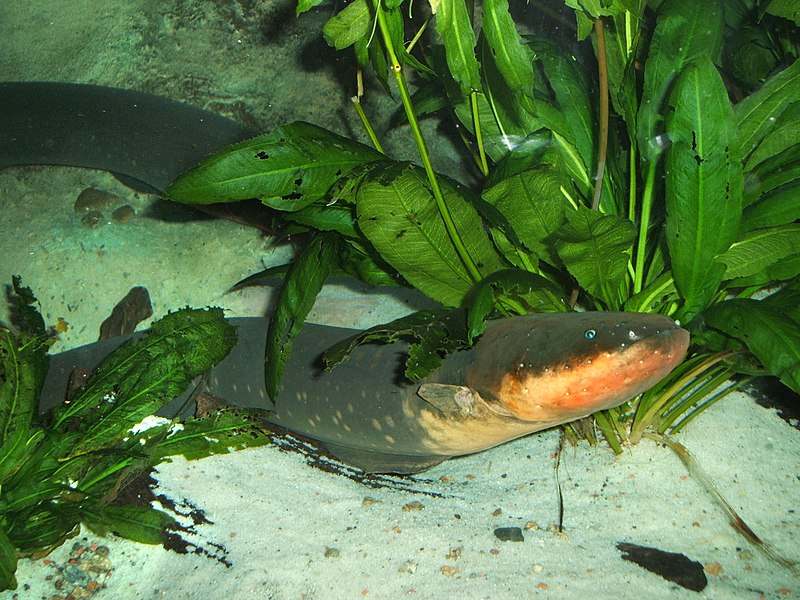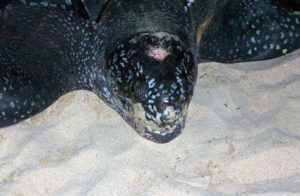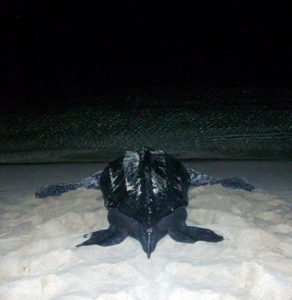Hello, Frank Indiviglio here. Fishes outnumber all other vertebrates combined, with nearly 30,000 species identified so far. No doubt, the ability to learn has assisted in this success. In Part I of this article, I recounted my experiences with “educated” electric eels in Venezuela, and gave some other examples of fish intelligence. I’ll continue here, with an emphasis on memory.
If you would like to experiment with your own pets’ learning abilities, please check out our extensive line of fish feeding products , and don’t forget to write in with your observations.
Memorizing Terrain
Frillfin gobies inhabit tidal pools. When disturbed, a goby will leap from its pool to several others in succession. It always lands in another pool, despite the fact that it is jumping without seeing the next pool, and changing directions.
Ichthyologists (fish biologists) have discovered that gobies memorize the location of tide pools at high tide, when they swim about over the area in which they live. Imagine, if you will, trying to do this yourself while snorkeling…and then consider the how much more complicated the task would be to a tiny fish!
Gobies transplanted to unfamiliar tide pools refuse to jump…if forced to do so, they invariably miss the next pool and hit dry land. Yet after just one high tide, the gobies learn the new habitat and can then jump accurately from pool to pool. In what must surely be the most amazing fish memory feat known, the tiny fishes retain their internal map of the new tide pools even if removed from the area for 40 days!
Learning by Observing Others
 Sea bass were allowed to watch other bass undergo a training program in which the participants were rewarded with food if they pushed at a certain lever. Some bass were better than others at learning this skill. “Student bass” that had watched “smart” bass immediately pressed the levers themselves when given the opportunity. Those that had observed bass that did poorly in the training took much longer to master the lever trick themselves.
Sea bass were allowed to watch other bass undergo a training program in which the participants were rewarded with food if they pushed at a certain lever. Some bass were better than others at learning this skill. “Student bass” that had watched “smart” bass immediately pressed the levers themselves when given the opportunity. Those that had observed bass that did poorly in the training took much longer to master the lever trick themselves.
French grunts travel from sleeping to foraging grounds each day. Grunts re-located to new habitats follow resident fishes to and from foraging grounds. After 2 days, the transplanted fishes are able to find their way to the foraging grounds – an average distance of .5 miles – even if the resident grunts are removed.
Goldfishes that watch others foraging in an aquarium with hidden food are able to learn and remember what areas of the tank held food. When released into the tank, they ignore areas where the original fishes found no food, and head immediately for the most productive feeding sites.
Remembering Bad and Good Experiences
 An American eel that was my mother’s (somewhat unusual!) pet for 17 years quickly learned to associate people with food. It was kept in a high-traffic area, but did not rise to the surface for food unless someone stopped in front of its aquarium…people passing by were ignored.
An American eel that was my mother’s (somewhat unusual!) pet for 17 years quickly learned to associate people with food. It was kept in a high-traffic area, but did not rise to the surface for food unless someone stopped in front of its aquarium…people passing by were ignored.
Perch separated from minnows by a glass partition stop trying to catch the minnows after crashing into the glass. When the glass is removed, the perch refuse to chase the minnows, apparently associating them with a bad experience. Note: this lesson wears off when predators get very hungry, so don’t try it in hopes of keeping Oscars with sword tails!
Further Reading
You can read more about fish learning abilities in an interesting Fish and Fisheries article and in The Everything Aquarium Book.
Please write in with your questions and comments. Thanks, until next time, Frank Indiviglio.
American Eel image referenced from Wikipedia and originally posted by Freida.
 That Fish Blog – Aquarium Advice and Information
That Fish Blog – Aquarium Advice and Information

 As you can imagine, forming associations similar to “people=food” can increase hunting success in the wild.
As you can imagine, forming associations similar to “people=food” can increase hunting success in the wild. Animals which cannot flee from predators must devise alternate means of protection…an arsenal of protective chemicals, for example. Also, the feeding mode utilized by many sponges and other sessile organisms – filtering seawater – brings not only food but also harmful pathogens and parasites into their bodies. These are attacked with potent antimicrobial compounds.
Animals which cannot flee from predators must devise alternate means of protection…an arsenal of protective chemicals, for example. Also, the feeding mode utilized by many sponges and other sessile organisms – filtering seawater – brings not only food but also harmful pathogens and parasites into their bodies. These are attacked with potent antimicrobial compounds. Bryostatin, isolated from colonial marine invertebrates known as bryozoans, or moss animals, forces cancer cells to mature, thereby halting their ability to divide.
Bryostatin, isolated from colonial marine invertebrates known as bryozoans, or moss animals, forces cancer cells to mature, thereby halting their ability to divide.  During my college days, I participated in loggerhead sea turtle nesting studies and research along the South Carolina coast. Our volunteers would walk the beach every morning looking for the telltale “crawl”, the tracks made by the female turtle as she crawled up the beach to lay her nest, but we very rarely ever caught a glimpse of the turtle in action.
During my college days, I participated in loggerhead sea turtle nesting studies and research along the South Carolina coast. Our volunteers would walk the beach every morning looking for the telltale “crawl”, the tracks made by the female turtle as she crawled up the beach to lay her nest, but we very rarely ever caught a glimpse of the turtle in action.